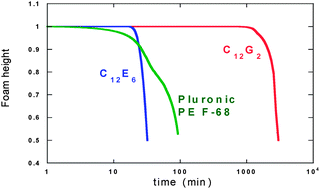Link between surface elasticity and foam stability
Abstract
We have measured the surface dilational elastic moduli of bubbles immersed in

a Laboratoire de Physique des Solides, UMR CNRS 8502, Université Paris 11, Orsay, France
b Teclis-IT Concept parc de Chancolan, Longessaigne, France
We have measured the surface dilational elastic moduli of bubbles immersed in

 Please wait while we load your content...
Something went wrong. Try again?
Please wait while we load your content...
Something went wrong. Try again?
D. Georgieva, A. Cagna and D. Langevin, Soft Matter, 2009, 5, 2063 DOI: 10.1039/B822568K
To request permission to reproduce material from this article, please go to the Copyright Clearance Center request page.
If you are an author contributing to an RSC publication, you do not need to request permission provided correct acknowledgement is given.
If you are the author of this article, you do not need to request permission to reproduce figures and diagrams provided correct acknowledgement is given. If you want to reproduce the whole article in a third-party publication (excluding your thesis/dissertation for which permission is not required) please go to the Copyright Clearance Center request page.
Read more about how to correctly acknowledge RSC content.
 Fetching data from CrossRef.
Fetching data from CrossRef.
This may take some time to load.
Loading related content
